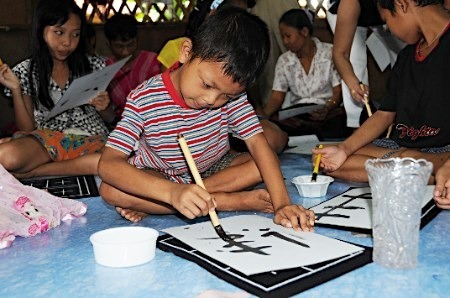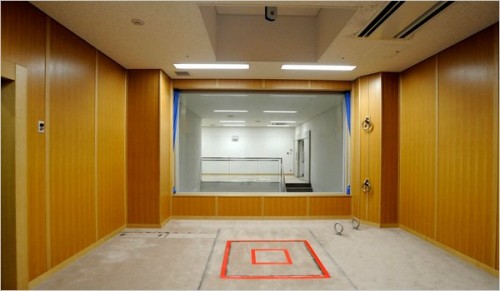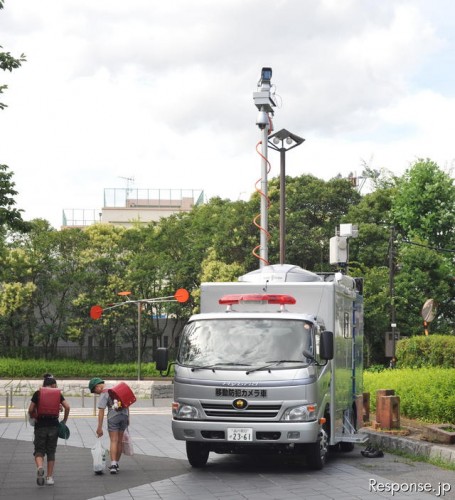
Kim Jong-un (金正恩), next leader of North Korea

Larry Sellers, D student and non-owner of brand new red sports car

Kim Jong-un (金正恩), next leader of North Korea

Larry Sellers, D student and non-owner of brand new red sports car
Starting toward the end of September, a group of 27 Karen refugees will resettle in Japan.
The refugees currently live in Thailand, part of more than 100,000 Karen people living in refugee camps in Thailand, along with thousands more living among the Thailand general population. The Karen are natives of Burma, where their people have been waging guerrilla warfare against the central government since the end of World War II. In response, the Burmese army has waged a campaign of torching villages and terrorizing people to try and weaken support for the insurgency. Talk about a Long War.
You can get many details from this English-language Asahi report (emphasis mine).
Twenty-seven refugees from five families–all members of minority Karen tribe–will be relocated from the camp to Japan in late September. They will be the first group to arrive under a “third-country” resettlement program adopted by Japan, which has long been criticized as closed to refugees.
The program is designed to help refugees in camps outside their home countries.
…
“We have no worries as long as we stay here,” [one of the 27] said in Karen, as he sat on his knees. “But I want to see our lives improve. I want my children to have goals and dreams. I will go to Japan to live a new life.”
He said he wanted to farm in Japan. “I believe I will manage if I make the effort.”
Since late July, those accepted under the resettlement program have been taking one-month training courses from the International Organization for Migration, which was commissioned by the Japanese government.
Initially, 32 members of six families were accepted, but a family of five decided not to move because of Japan’s high prices.
A 36-year-old man in a family of seven did not hide his anxieties about living in Japan.
“Away from Myanmar, without knowing the language, how can I possibly find a job soon?” he said. “But there is no future in this camp. I will do my best trying to become a naturalized citizen.”
An 8-year-old girl has also set goals for her life in a new country.
“I want to go to school and make many friends. I want to get in a car, too,” she said.
Japan plans to accept about 90 refugees from Myanmar in three years from this fiscal year.
Best of luck to them. The government apparently plans to train them in Tokyo for a while before finding a suitable place for them. In any case, relocation of refugees is tough. The children will probably have the easiest time assimilating. In Bangkok, Mrs. Adamu used to work with Burmese refugees, including several Karen. They often had only just arrived in Bangkok, and because it was their first big city, a lot surprised them. They’d get scared on elevators, throw up in taxis, never been bowling or seen a movie in a theater before. These folks are in for some serious culture shock, especially the adults. The first winter will probably be a little scary.

Little boy learning Japanese writing, courtesy Yahoo News
This move by the Japanese government comes after years of pressure from the US, the EU and other nations that participate in refugee relocation programs. Japan accepts a fraction of applications for refugee status made on Japanese soil, but it has previously not taken part in third-party settlement programs. In contrast, the US receives tens of thousands of refugees every year resettling for various reasons, recently in the aftermath of the US invasions of Iraq and Afghanistan.
In recent years, upward of 80% of Japan’s refugee applications have been filed by people from Burma because of stepped-up pressure by the junta and pressure on overflowing refugee camps. There are an estimated 10,000 or so Burmese living in Japan, with a particular concentration in the Takadanobaba area of Tokyo (notable for delicious and authentic Burmese restaurants). Near the industrial complexes in greater Kanto, Burmese workers can be found work
In the past, Japan accepted many “boat people,” refugees from Vietnam who fled political persecution after the communists won control of the country in the mid 70s.
The Vietnamese experience in Japan has been mixed. English Wikipedia actually has a fairly detailed article on this, noting that while many of the original refugees had trouble integrating, many of the 2nd generation are completely assimilating, taking Japanese names and perhaps not even mentioning their non-Japanese heritage to people they meet on a daily basis. With their distinctly Southeast Asian features, the Karen may not have that option.
It’s unclear at this point where the new arrivals will live or how exactly they will be taken care of (unclear to me at least; I am sure MOFA has plans), but generally they can be expected to receive some form of government assistance for the foreseeable future. They will also benefit from being first, which will bring extra attention and a greater commitment to get things right. But eventually they and their children will have to form some connection and relationship with Japanese society, along with the hundreds if not thousands more who will follow. Much like the test groups of Indonesian and Filipina nurses, these refugees will be yet another test case for Japan’s immigrant experience.
Japan’s justice minister has allowed media to come in and look at the gallows where the executions take place:

Here is a video from TBS with more details. Apparently, the whole place smells like burning incense. The reporter has a good description of the room – 無機質 which literally means “inorganic” but I guess would be more naturally conveyed as sterile and banal.
The room is located at Tokyo Detention Center, which is a 20-minute or so walk from my house. It’s always a little disturbing to think this is where it all goes down.
I would strongly encourage people to read the NYT’s article, written by superstar Japan reporter Hiroko Tabuchi who should go down in history as their best ever Japan correspondent.
According to accounts in local news outlets, journalists were taken to the execution site in a bus with closed curtains, because its exact location is kept secret. There are seven such sites across Japan, the Justice Ministry said.
The journalists were led through the chambers, one by one: a chapel with a Buddhist altar where the condemned are read their last rites; a small room, also with a Buddha statue, where a prison warden officially orders the execution; the execution room, with a pulley and rings for the rope and a trapdoor where the condemned inmate stands; and the viewing room where officials witness the hanging.
The inmate is handcuffed and blindfolded before entering the execution room, officials said. Three prison wardens push separate buttons, only one of which releases the trapdoor — but they never find out which one. Wardens are given a bonus of about $230 every time they attend an execution.
Satoshi Tomiyama, the Justice Ministry official who later briefed the foreign news outlets and others excluded from the tour, said that wardens take the utmost care to treat death row inmates fairly and humanely.
The Buddha statues can be switched with an altar of the indigenous Japanese Shinto religion for followers of that faith, he said. For Christians, the prison provides a wooden cross. Inmates are given fruit and snacks before their execution, and sentences are not carried out on weekends, national holidays and around the New Year.
What amazes me is that this system has been in place for so long even when just about everyone, including death penalty supporters, knows there are serious problems. If nothing else, the government needs to reform the itinerary for carrying out executions. It just seems exceptionally cruel and Kafkaesque to keep the execution date secret for so many years and only tell them at the last minute. I also see no reason why the justice ministry should be allowed to hide their decision-making process on when to execute people.
Via Roger Ebert, here is Filipino reviewer Michael Mirasol’s take on what’s so great about Miyazaki’s Nausicaa of the Valley of the Wind:
My favorite part (emphasis added):
The film is considered to be the first of Miyazaki’s works to showcase his strong environmental inclinations. In every film since he has made his case for man to grow closer to nature as a return to the olden days. He does so with positive reinforcement, hardly ever resorting to demonizing, moralizing, or sermonizing. Here, the toxic jungle isn’t so much an inhospitable realm as it is a fearsome marvel of nature. It’s huge arthropod denizens never come off as oozing grotesques, but wondrous (though scary) creatures. The film’s largest creations, the ohmus, are wholly original, and are almost proof that the eyes are the window to the soul.
Miyazaki’s refusal to narrow down conflict to two or even three sides is refreshing, and quite admirable considering its target audience. The film’s story does concern good versus evil, but they aren’t manifested in simplistic ways. Each populace has its own motivations. Each conflict has its reason. Wars exist among man and against nature. Several stakes exist. Even death is hardly out of bounds. For much of the film, there is no one problem/solution. But despite this moral complexity for an animated film, it all fits Miyazaki’s big picture, and in the end we see it.
The link has a transcript, so it might be easier to read that instead.
I think it’s a testament to Miyazaki’s subtle storytelling power (or maybe just my own lack of insight) that this point never explicitly dawned on me after watching the movie. It’s just a natural part of the landscape. And it’s surprisingly rare for movies to take this approach, though it seems to be a major feature of Miyazaki films.
At the risk of overgeneralizing, I sense a broader point here. One of the refreshing things about living in Japan is that people seem much less dogmatic than in the US. That is, issues are seldom as black and white as they seem in the States, and there seems to be less pressure to adopt the “correct” set of opinions based on political leanings. Could this have something to do with a generation raised on Miyazaki’s pluralistic stories as opposed to Americans growing up with Disney tales of good and evil?
Slate has an article on the missing centenarian scandal, and it could have been better. Go read the writer’s take. Unfortunately, the subtitle is wildly inaccurate, “macabre Japanese trend – mummify grandma and collect the pension – what America can learn from these macabre tales of mummified Japanese centenarians.”
I will concede that she is more or less right on most of the facts, taken separately. But ultimately this article leads nowhere and tells very little. It tries to combine many separate issues – the missing old people issue and the “parasite single/aging society” common explanations for the Japanese malaise – without really making the case for why they go together.
What bugs me most, though, is the detached approach. In reviewing her book The China Price, a Bloomberg writer called her style “breezy, almost florid” – spot on, if this article is a guide. I wish more writers would actually try to have some empathy for the situation here rather than looking down on Japan from a distance.
This is already widely reported, but just thought I would share an amazing, terrifying story that happened pretty close to where I live.
Basically, the headline says it all. Back in June, some local workers visited the home one Sogen Kato to present him with an award – at 111 he had become the oldest resident of Adachi-ku, Tokyo, and the second-oldest man in Japan (on paper at least). However, his 80-year-old daughter wouldn’t let them in – “He’s upstairs but doesn’t want any visitors,” she said.
Undeterred, the officials complained to the police, who eventually got to the bottom of things – according to family members, in 1980 the then-octogenarian Kato declared he wanted to become “enlightened through mummification” (pic possibly NSFW – 即身仏), so would they please leave him alone in his room forever with no food or water, thank you very much.
Apparently, this claim might be a ruse – however Kato died, it’s possible they failed to report it in a ploy to keep receiving his pension. If true, that’s an incredibly stupid way of providing for your family after death. If he had bought a life insurance policy the survivors could have paid for a proper funeral (and therefore “proper” Buddha-fication) and still had enough left over to provide. And the biggest upside would be no skeletal corpse in the house for 30 years! I mean, just think of what you could do with that extra bedroom.
There’s an interesting article in the NYT about what Twitter does to your inner dialogue. Basically, the idea is if you are Tweeting all the time you are “always on” and start thinking your life is a reality show.
Absolutely right! Just about anyone who’s used Twitter for an extended period of time could tell you that. In fact, a Google search for “I Tweet Therefore I am” shows multiple articles with that title on other sites, one on Gawker written eight months ago. But if that gets tiring or is turning you into an asshole, there is a simple solution:
Take a freakin break every now and again!
Remember when your parents said not to watch too much TV? Same thing.
As someone without an iPhone, Blackberry, or even one of the Japanese mobile web platforms, maybe I am being naive and behind the times. But I don’t think it’s too much to ask to maybe keep the phone in your pocket, temporarily disable the Twitter client on your browser, and concentrate for once. I am told that there are even times when the Internet itself isn’t necessary.
On Twitter (unlike Facebook), there seems to be less incentive to pay close attention to who is on your followed list or who sees your updates. People come and go, and even those who follow you only tune in when they are interested. That’s the beauty of the real-time web.
I realize I am somewhat late to this, but there’s been a flare-up of interest in “saving the JET Program” ever since the new government’s budget review panel apparently requested the internal affairs ministry to reform the program.
It’s been hard for me to figure out exactly what is going on, but judging from reading through the review results (PDF) and conclusions of the panel (helpfully posted by a commenter on the jetprogramme.org forum), my understanding is this:
As part of the review of the nationally subsidized “internationalization” operations of local governments, some argued for the JET Program to be eliminated. In the end, the panel concluded that the program deserves closer scrutiny in terms of how much of the costs local governments are responsible for, the status of overseas offices with questionable usefulness, and whether the 23-year-old program is meeting the needs of Japanese people today. The “conclusions” take the form of a formal request to the Ministry of Internal Affairs and Communication. Interestingly, I didn’t know that some revenue from the Japanese national lottery goes to fund the JET Program, which was also something at least one panel member objected to.
Ultimately, I would agree with Washington-based Sankei senior writer Yoshihisa Komori who sees the JET Program as necessary to spread understanding and good will toward Japan, even while admitting the need for some reforms and re-focusing of its mission. He cites the example of his acquaintance Irwin, an African-American who as a JET learned the way of bushido through judo lessons on the side.
Why Japan really needs the JET Program
As Komori emphasized, JET alumni are some of the best friends overseas Japan could hope for. They often go to work in government and industry, and their familiarity with Japan produces both good will and a smooth working relationship in many cases. That’s a point I noted when JET turned 20 back in 2006.
But I would add a perhaps more important reason for continuing JET – a reliable supply of Japanese-speaking native English speakers. While JET has proven successful in some ways, it has failed miserably in one crucial other – by and large, Japanese people still can’t speak English! Obviously, this isn’t JET’s fault. Intentionally or not, Japan’s education system produces people with a large English vocabulary that they cannot put to practical use, creating a “Berlin Wall” separating the majority of Japanese from meaningful contact with the English-speaking world.
The JET Program has brought tens of thousands of native English speakers to Japan. Some of them get very good at Japanese. These people can then make careers for themselves as translators, interpreters, or “gaijin gophers” wherever they work, filling the gaps created by a paucity of English ability among the general workforce. I am not sure what Japan was like 20 years ago, but this need remains vital today.
There is a large population of private-sector ESL teachers as well. However, the advantages of the JET Program include a rigorous admissions process and a generous compensation package, which help guarantee a positive experience and make the program look better on resumes. Private-sector English jobs have turned out to be potentially very unstable, so keeping this “public option” might be a good idea.
Hopefully, the budget reviewers and the internal affairs ministry will understand this message. Komori-san, head back to Tokyo and make your case!

This is the scene outside my apartment these days. Apparently, the Tokyo police are using a new tactic in efforts to catch bicycle thieves and purse snatchers near Ayase station.
The van is equipped with high-powered cameras that can take hi-res images with a 100m range in all directions. I saw them conducting tests a few months ago. The report emphasizes that the cameras are not running while the vehicle is in motion, and that local residents were duly warned about the cameras.
The van really stands out, as you can see. It looks like the FBI is staking out a mob boss’s house. When I first saw them testing the thing a few months ago I thought they might be preparing to film a movie. Looks like I was only half right.
The police must have invited the media to report on this new initiative because there’s also this video report. It’s cool to see my neighborhood in the news, but knowing the cops think Ayase is a hotbed of crime, while not surprising, isn’t exactly comforting.
It’s worth noting that Adachi-ku (where Ayase is located) has launched a so-called “beautiful windows” campaign. In an attempt to reduce crime in Tokyo’s most dangerous area, the government is trying to mimic the success of NYC in the Giuliani years by encouraging citizen patrols, banning smoking on the street, and painting murals on shuttered storefronts. This may dovetail with those efforts somehow.

The Japan tourism agency is saying (sub req’d) they plan to ease a strict ban on tour guide interpreters getting paid for their services. As it stands, only nationally licensed guide-interpreters can get paid; as a result, you can see many “volunteer” interpreters at tourist destinations. Other translations do not need any certification, as far as I know.
Now, they aren’t completely eliminating the qualification program or abandoning quality standards for tour guides, as this key passage makes clear:
The Japan Tourism Agency thus decided to allow people without formal qualifications to charge for their services, while maintaining the current certification program for highly skilled interpreter-guides. The agency hopes to submit a bill to revise the rules to next year’s regular session of the Diet at the earliest.
Still, the agency determined that a certain level of quality, if not national certification, is needed for those who work as guide-interpreters. It is therefore considering drawing up guidelines and having municipalities and private-sector companies certify those who undergo training.
An official with the agency said revising the rules would allow the roughly 54,000 Japanese who now act as volunteer guide-interpreters to better use their skills, and help create jobs for foreigners living in Japan.
So that’s one more group that’s losing protected guild status, much as Japan’s barbers did years ago. Having a strict national qualification requirement for such a minor occupation seems like overkill to me. I can see why the tourism regulators want to maintain quality, though – a situation like the child tour guides at the Taj Mahal in Slumdog Millionaire would probably be a worst-case scenario.